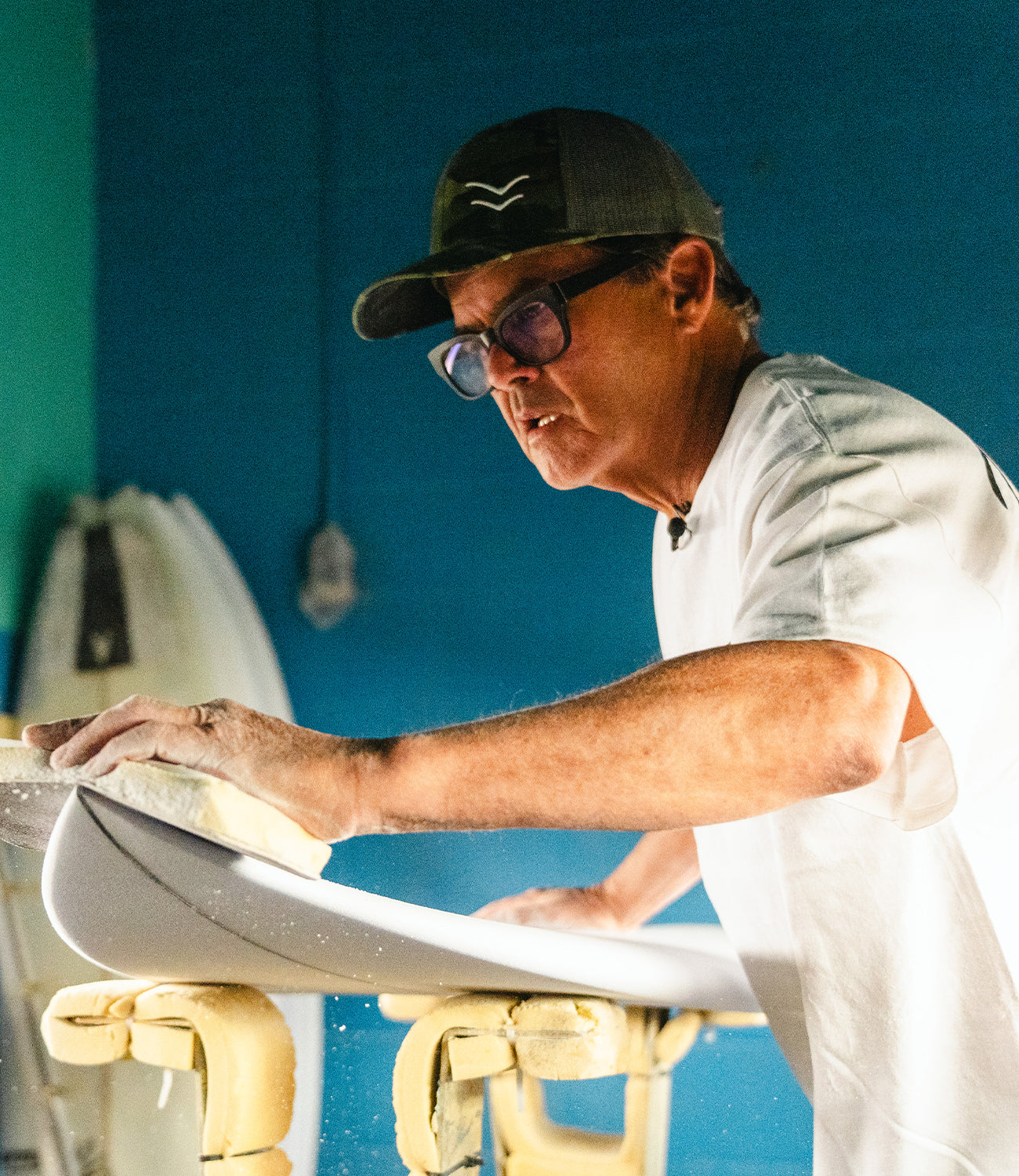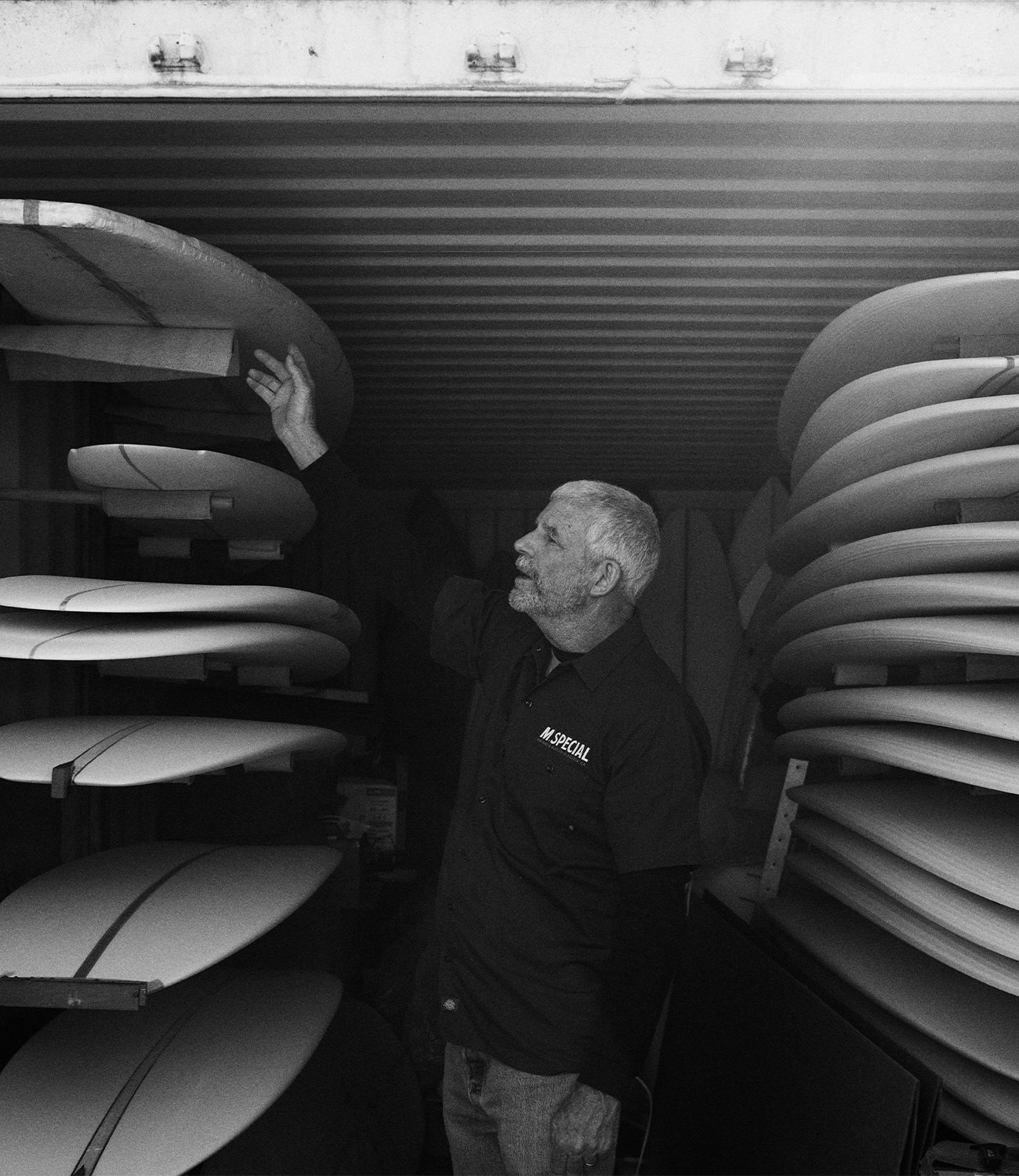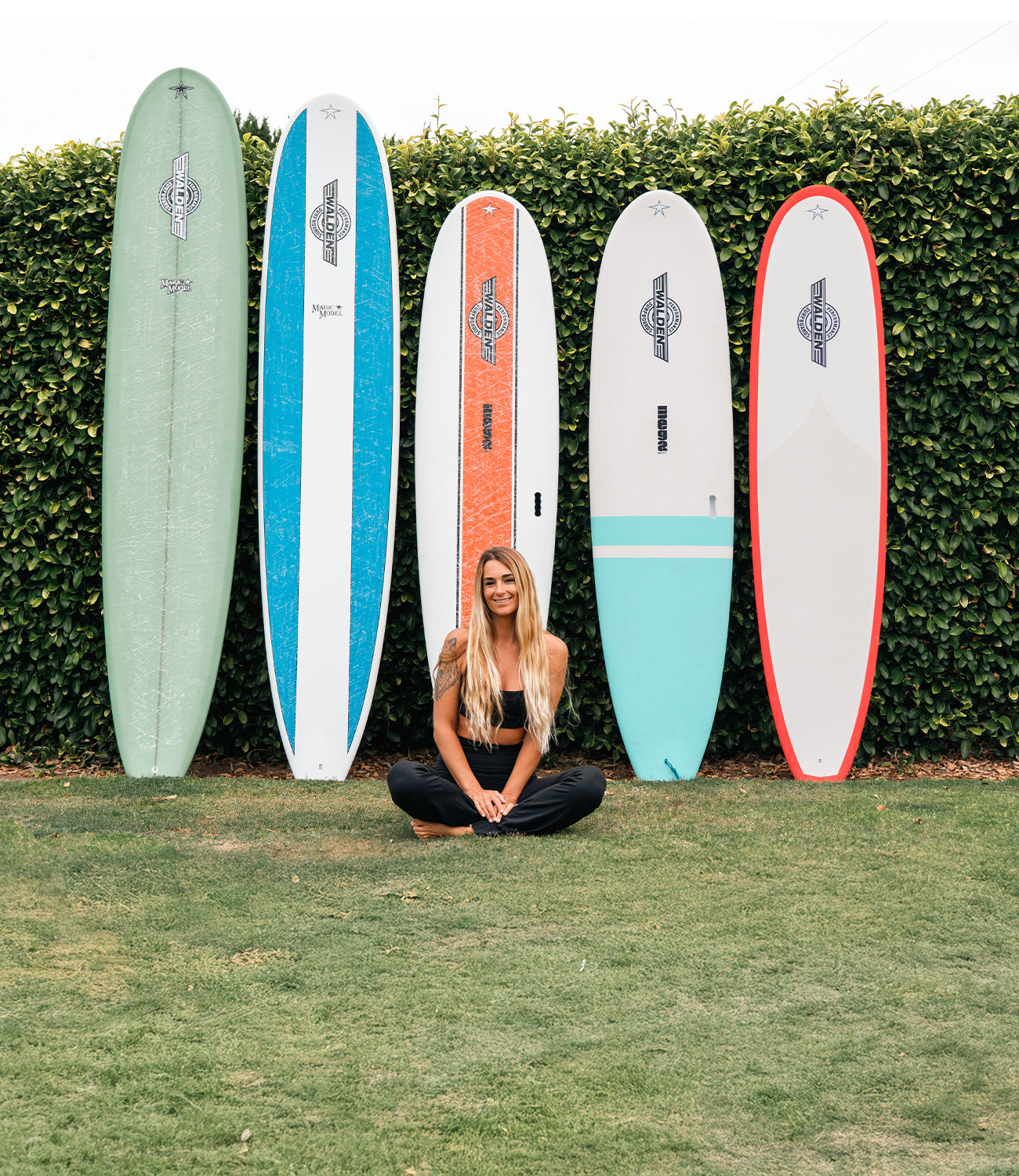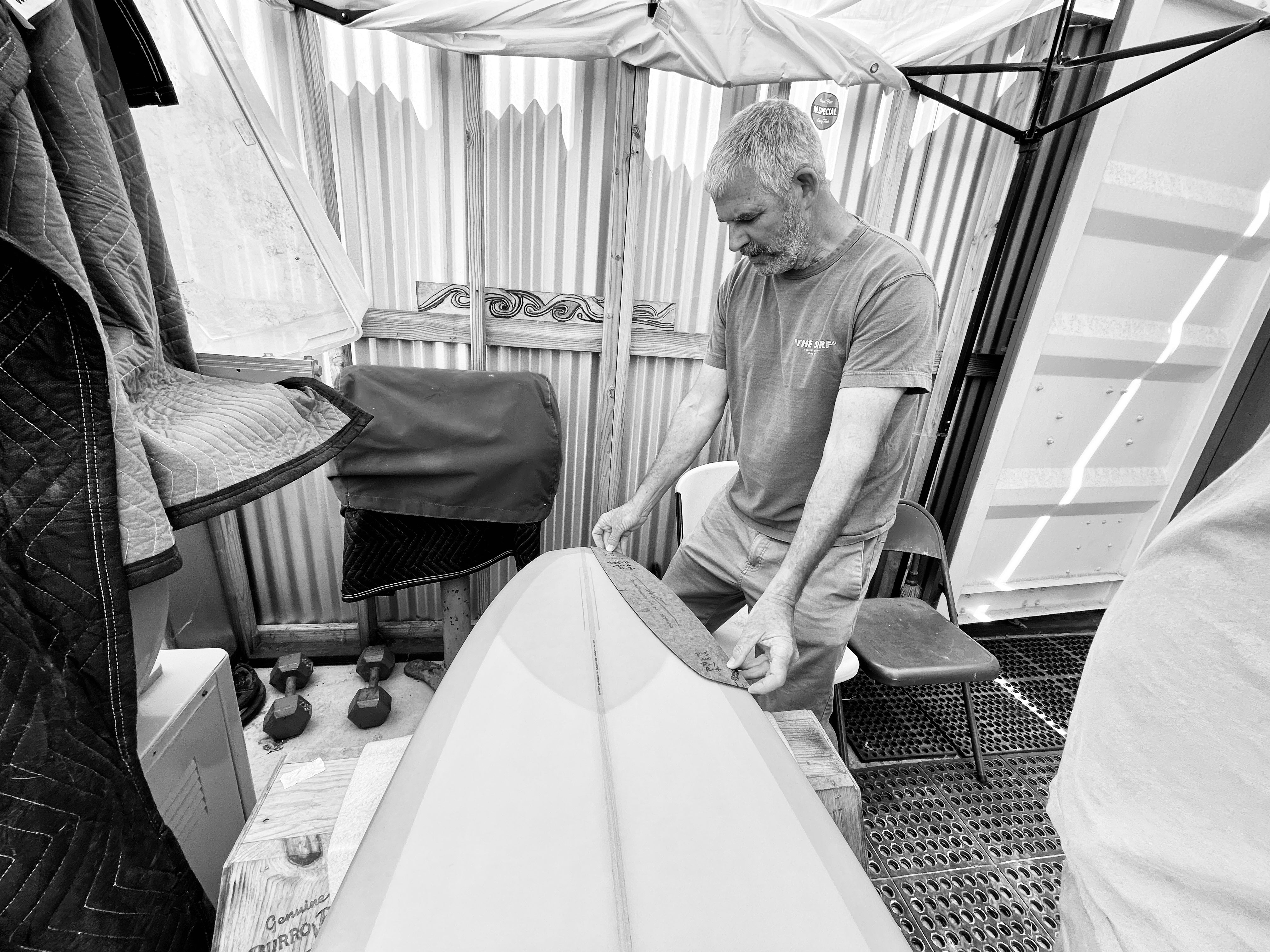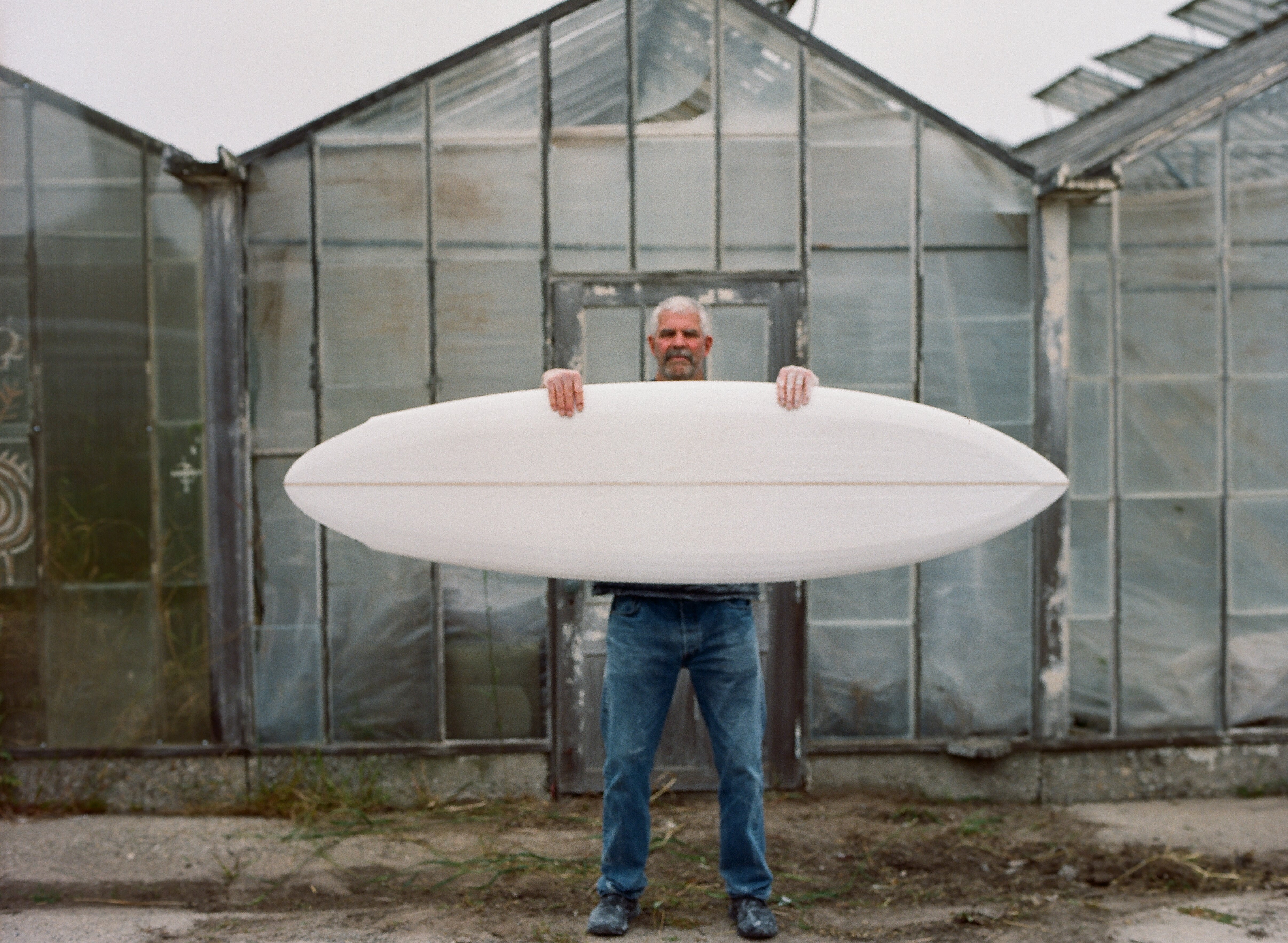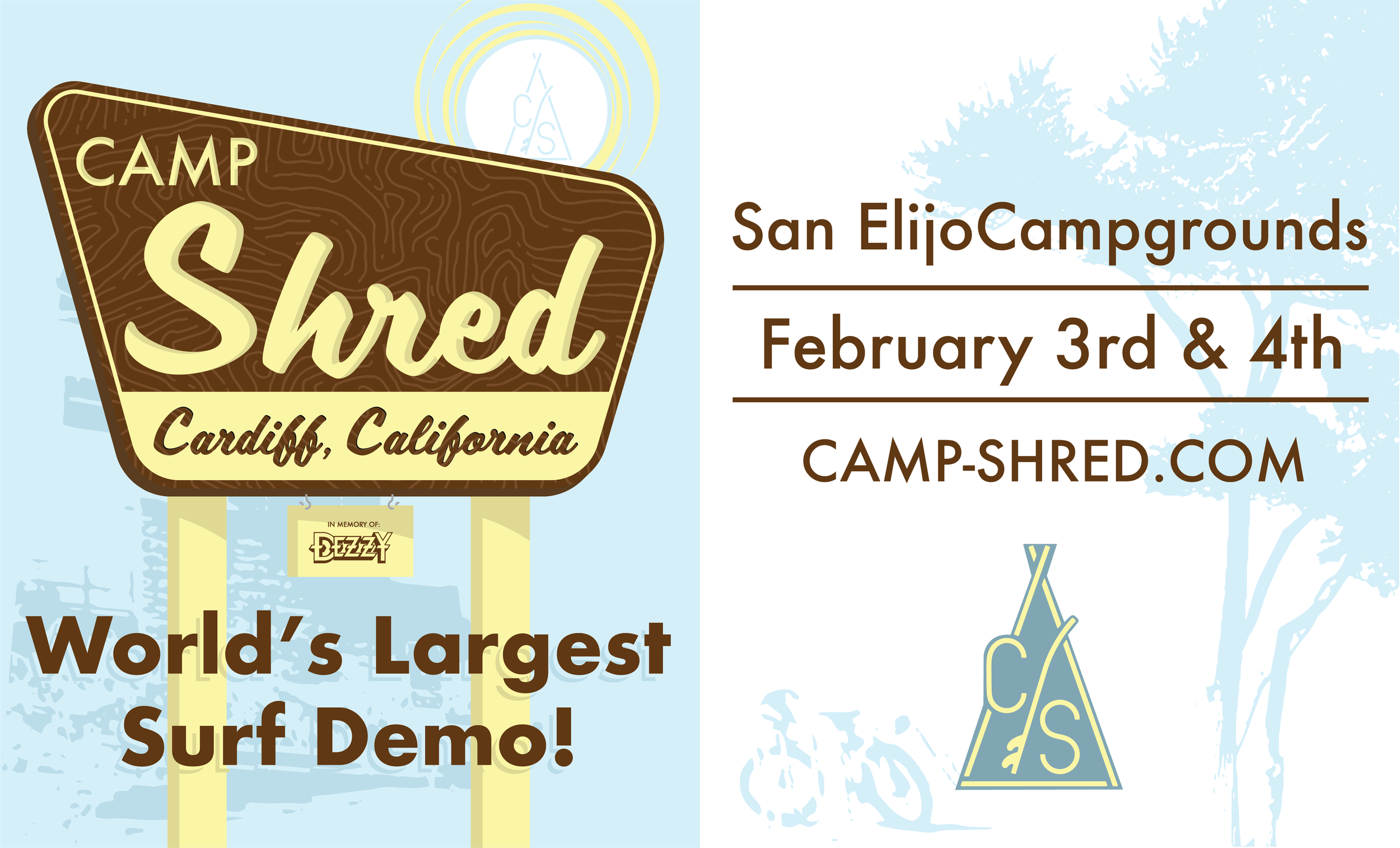Wayne Rich is a world-renowned surfboard shaper who has been designing boards for over 40 years. He is known for his progressive designs, attention to detail ,and quality craftsmanship. Born and raised in Hermosa Beach, CA Wayne began shaping under Dan Bendiksen at Bing Surfboards, from there he continued on to become part owner of Jacobs surfboards, and then eventually started his own label. Wayne is a 2x Boardroom show winner whose respect for tradition is only matched by his need to innovate.
State your name, occupation and the first thing
you thought about this morning.
Wayne Rich surfer, shaper, designer, fabricator, craftsman and I don’t know, artisan, mostly though, perpetual student. I think that’s mostly what I am. First thing I thought of this morning was visualizing dropping into a steep critical section of a wave. I always like to think about how the water flows over the rail on the inside rail, especially the way it holds us in control. And we can kind of play with it and feel that feeling of that water holding us. The tension of that water holding us up the face of the wave and releasing down and how we can transition it to the speed off the back of the board, the way water flows across the rail and the bottom of the board releasing behind us and allowing speed and freedom of movement, that kind of stuff just still fascinates me all the time.

Tell us about your early surfing days.
Early days of surfing, wow, I have to go back to my mother, Roberta. She was an early water woman who put me under my first wave at three years old. She taught me not to be afraid. She got us all riding little air mattresses and little paipo belly boards and things. My friends, Mike Pace, Bruce Tuttle, and I used to try to stand up on those things; we’d try to surf those little things. We’d surf those mats. We would air them up real full and blow them up at the gas station so that we could stand up on them. We started riding regular surfboards by the time we were eight or nine. They were big, heavy things back then. It was a man’s sport at the time. It was tough. It was just a tough time in general. Surfing and surfboards were crazy. Redondo Breakwater to Hermosa Pier was my main area back then. That is where I grew up with all my friends.
Along with Bendiksen, Mike Pace, Mike and Bob Behnke, Mike Behnke ran the Bing shop later on; we all used to surf 10th Street a lot in those days. They called it the dime back then. We’d surf from there up to 22nd Street during those early days. It was neat to go up there to 22nd as a kid and watch all the older guys, Dewey, David Nuuhiwa, Donald Takayama, Leroy Grannis, Skipper Fats Harwood, Henry Ford, Ricky Hatch, Darrell Dickey, John Baker, Alfred Laws, Bing Copeland, Phil Beckerand many more; all of them were up there. It was quite a time; you could drink on the beach then, so it was pretty wild. Looking back on it, I feel lucky to be influenced by them and that whole crew up there.
Henry Ford claims 22nd Street Hermosa was where hot dog surfing was invented. That’s his claim, and I’d say he’s pretty accurate. It was a neat thing to be around it all.
"...It was pretty wild. Looking back on it, I feel lucky to be influenced by them and that whole crew up there.
Henry Ford claims 22nd Street Hermosa was where hot dog surfing was invented.”
As we entered the 70s, the scene moved toward The Breakwater and Southside of Hermosa Pier. That’s where I’d watch Mike Pace ripping it up alongside Bobby Warcola and Mike Purpus. There were a lot of great local guys. What a time! Later on, we’d started traveling up to Hollywood by the Sea in Oxnard for some real juice, and it was wild up there, localism at its fullest, and we respected them. In exchange, they allowed us to ride a few waves – sometimes. I ended up living in Oxnard a few years later, but we will get to that in a different story. What else can I say? It was all quite the experience. Let me add a few names to that last list of people who influenced my early surfing: Steve Slickenmeyer, Chrissy Slickenmeyer, Wayne Miyata, and Drew Harrison. I mean, tell you what, there was so much talent around there back then I couldn’t name them all, but it’s fun to look back and try. That old 22nd Street thing was a special time, and it was all captured on film by Leroy Grannis when he wasn’t surfing; it was unbelievable.
Can you remember the best wave you’ve ever ridden?
Okay favorite wave or something ridden, I don’t know, I’m not much to talk about that stuff, but – where would it be? Let me think, was it at a beach break, point break, reef break? I can’t pick very easily there have been so many. I mean Hollywood by the Sea as big as the beach will handle, one time a left morphed out from the middle of the beach with all the power shifting off the canyon. I was riding an 8’4” gun and I got this backside tube ride that was just... I don’t know... Pretty crazy. That was back in the 90s, but there have been a lot of others that were different. That one comes to mind first though. That was one of the highlights of my life. With that crew of guys. They were heavy people who demanded heavy respect because that wave has heavy power. I’ve almost lost my life twice on that beach. So, I guess that one would rate pretty high.
Can you expand upon the importance of Oxnard in your life?
My best friend Mike Pace dragged me out of Hermosa because I was on a bad path with drugs and alcohol. He got me up there to Oxnard. But even up there, I got into trouble and got locked up several times. I was looking at a lot of problems. Oxnard is where I figured it out, though. With the help of a lot of friends, the grace of God, and the 12-step program, I was able to clean my life up. The raw power of Hollywood by the Sea was a great place to immerse myself and feel the humility of what I was going through. Just paddling out there will humble you. At the time, the locals there were good enough to take me in and allow me to be a part of something special. That was the end of true localism, and working my way into that community meant a lot to me. The thing about Oxnard is it’s got so much power, it’s got just such a heavy feeling in the water, and the vibe around there is raw. The sea life around there is pretty radical too. That feeling of power makes it really interesting. It’s almost an ominous power in a lot of ways. That power and the people down there helped me understand what was essential and helped guide my life.

Where are you at with your surfing now days?
Surfing, well, it’s a lifesaver. It’s a continual lifesaver and a break from the reality of what the world is doing. It’s a great escape. I feel like I don’t really have anything to prove to anybody else in the water anymore. Surfing is more personal. It is a place I can work on my fitness and push through all the pain from past injuries. I’m fortunate I still get the opportunity to surf, and I am very thankful for it. So really, it’s just trying to hang on by my fingernails and still do things right out in the water. I love surfing. I love watching people ride waves and how much joy it brings everybody to be out there together. I really dig that whole part of it. Don’t get me wrong, I still get intense at times in the water when I’m feeling good, but it’s just all fun. That intensity and the joy of surfing make me feel like a kid. For that reason, I have to keep doing it until I die. There was a time when I didn’t think I would be able to keep surfing. After I got hurt in 2007 and got the titanium plate put in my neck, I didn’t know if I could surf again. Thank God for neurosurgeon Jay Herman, head trauma surgeon Javier Romero, and chiropractor Kevin English. Those three put me back together. Thanks to them, I’m still allowed/able to get out there and surf. It’s an amazing gift, and because of good friends encouraging me never to stop, I won’t. It is important to me that I can still evaluate and validate a board I shaped with first hand experience. Luckily I am still in a place with my surfing where I can do that. I’m stoked about that. Getting out in the water and getting that first hand evaluation of a surfboard design, fin placement, or fin design is unreplaceable for a surfboard builder. Of course, I can’t push certain limits on the boards these day, but I’ve got people who ride the boards that I work with, and I’m fortunate to have them and their feedback.
How did you get into shaping? Shaping surfboards is an often romanticized profession; if you were to give the cold and honest truth to somebody getting into shaping, what would you say?
Well, I rode for Bendiksen, and I rode his boards. One day he didn’t want to make me exactly what I wanted. And we kind of bickered over what to do. And he just told me, “You need to start shaping your own boards,” and he really said, “you know, you should do it.” That was kind of a really cool thing that he did for me, because he said, “Now you have your own ideas and your own mind, and you need to explore that stuff on your own, learn how to do it.” So Bendicksen pushed me into it and Mike Geib was right there around that time to help. He really helped me a lot on understanding a lot of theory. So that was how that started. Now, advice to any young person. All I can say is this. Yeah, it is romanticized. If you want to go deep into it, and be real, it’s it’s like anything that’s got 1000s of variables about it. You just have to start and you need to keep at it for a long, long time and be diligent and treat it like a martial art. There’s no way to learn everything. So you’ll spend your whole life and you’ll get as far as you get through how much work you’ve put into it. And that’s it, hopefully you can enjoy it as much as possible. But if you want to learn, you’re going to have to go through a lot of failures to learn how important those failures are so that you can get to the good stuff. So it just takes a lot of patience and a lot of perseverance, but like anything if you want it bad enough and you do the work, you’ll get the results.

Who are your biggest influences?
Let’s see who influenced and helped me along the way with shaping. My biggest mentor would be Dan Bendiksen. Bing Copeland was also a significant influence, but Danny was like a second father to me. So he was my biggest mentor and guiding light regarding everything besides shaping in my life. Mike Geib, Bob Manville aka Redman; he was a really creative guy and a big influence. Phil Becker was the guy who really straightened me out and taught me how to handle the bigger tools.
We all used Rockwells and Skil 100’s back then. You were considered a baby if you didn’t use the Rockwell. The Skil was considered an electric surform. Phil Becker, Mike Eaton, Jeff Weidner, at the time, John Lessing, and Donald Takayama, when he was around back then, was a big influence and always really helpful. These are all incredible people. And then, you know, my San Diego connection was always to Hank Warner through my friends Mike and Bob Behnke, Mike was the manager at Bing, and then he moved down to PB surf shop and managed that shop, and that’s how I got connected to Hank Warner. I used to ride some a Hanky’s boards, so Hank Warner is a huge influence. Sidney Madden down there was one of the greatest underground shapers of all time. Skip Frye, of course, was always a huge influence. And Billy Castor was probably one of the biggest influences during the 70s, he was just a super creative guy. He was incredibly good at foiled out single fin shapes and wing round pins. John Bradbury up in Santa Barbara and Renny Yater were huge influences and special people to work with. Bob Duncan is another underground guy from up at The Ranch who really influenced me. Bob makes all the edge boards you’ve seen over the years. He had the wilderness label with Greenough back in the day, and he’s still got it and carries it on. He’s a huge influence. Other people in the South Bay I was blessed to work with include: Ray Lucke, Eddie Peiper, Rabbit Kekai, Wayne Miyata, Dewey Weber, Sam Harwood, Lance Carson, Dale Velzy, Jeff Wiedner, John Lessing, Zen Del Rio, Tom Stranton, Jack Meyer, Don Kadawaki, Mike Collins, Chris Slickenmeyer, Pat Ryan, Steve Mangaiglai and Bobby Jenson. Moving north I worked hand in hand with Renny Yater, John Bradbury, Clyde Beatty Jr, Max McDonald, Matt Moore, “Army” Michael Armstrong, Roger Hinds, Butch Towers, Steve Huerta, and Kevin McClelland. In San Diego I worked hand in hand with Stu Kenson, Joel Tudor, Joe Roper and Joe Blair. Many of these names I just listed I still work with today and I honor, appreciate, and respect them all at the highest levels.
Who do you make most of your boards for?
Who do I make boards for? Great question. I make boards for everybody from beginners to recreational people, all the way up to the highest level of local surfers, and even all the way up to people like Joel Tudor, Devin Howard, and Cole Robbins(Ranked #5 on the WSL). Just great local surfers for the most part that’s who I make most my boards for.

How and why did you get involved with Surftech?
I’ve been trying to work with Surftech for over 21 years. It’s only now that we’ve finally been able to put something together as I was working with some other people. But as timing would have it, I was fortunate enough to be approached by Surftech a couple of years ago, about the idea of doing some things, and I’m super excited about it. And so now after 21 years, I finally get to work with some great people and make some boards that reach out globally. I’ll always still make some of my own stuff by hand. I’ll always make polyester boards my way, but I’m just super stoked to be allowed in the group of Surftech builders.
Is it the surfer, the board or the wave?
Is it the surfer, the board or the wave? Oh I like this one? Yeah, without all three, you have nothing in my opinion. So, my answer to that is that you need to have all three to have the package. But you can’t become the surfer if you don’t have the board, you can’t become the surfer if you don’t have the wave, and there won’t be a surfer if there isn’t a wave to begin with.



